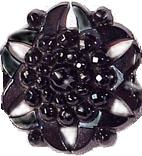
 |
| Our subscribers' grade-level estimate for this page: 3rd - 5th |
 |
Rock and Mineral Dictionary |
 |
| A | B | C | D | E | F | G | H | I | J | K | L | M | N | O | P | Q | R | S | T | U | V | W | X | Y | Z |
jacinth Jacinth is a semi-precious stone that is also known as hyacinth. it is a lustrous orange-yellow, orange-red, or yellow-brown type of zircon. Hyacinth has a hardness of 7.5 and a specific gravity of 4.65. Sometimes, topaz and grossular garnet of this color are also referred to as hyacinth (this can be very confusing). Hyacinth is mined in Sri Lanka. Even more confusing is the origin of the name, which comes from the Greek hyakinthos, which refers to blue gemstone. |
 jade Jade is a semi-precious stone that ranges in color from green to white to lilac to brown to almost black. Translucent jade is more highly valued than opaque jade. Jade is often cabochon set; stones with imperfections are often carved (the imperfections are simply carved away). Two different minerals are known as jade: jadeite and nephrite. Jadeite is the harder of the two; it is usually used in jewelry production. Nephrite is slightly softer and is often veined; it is used in carvings, for making beautiful bowls and vases. The Chinese have prized jade for thousands of years and regarded it as having medicinal properties when worn or ingested as a powder. Natural jadeite is called Type A or Grade A jade (waxing or wax dipping is allowed). Jadeite that had been bleached and then treated with polymers (plastic) or waxes is called Type B or Grade B jade (it is less durable than natural jade). Jadeite that had been dyed is called Type C or Grade C jade (the color is less durable than that of natural jade). Jadeite that has been both dyed and impregnated with polymers is called Type B+C or Grade B+C. |
jadeite Jadeite is the harder of the two varieties of jade. Jadeite is harder (compared to nephrite) and is usually used in jewelry production. |
jasper Jasper is a common, opaque, semi-precious stone that is found in many colors, including white, brown, yellow, red, and green. Jasper is found all over the world; it is often striped, speckled, and multi-colored. Jasper has been used for intaglio carvings. Jasper is a type of quartz belonging to the chalcedony family. It is often sealed with petroleum products. Jasper is sometimes dyed to resemble lapis lazuli and misleadingly called "Swiss lapis." Jasper has a hardness of 6.5 to 7.0. |
jasperine Jasperine refers to any type of banded jasper. |
jasperized wood Jasperized wood (also called xyloid jasper) is petrified wood. It is wood that has fossilized - all the original chemicals have been replaced with minerals, making a stone-like replica of the original wood. |
 jet Jet (also known as gagate) is fossilized coal. It is a hard, lightweight lustrous black stone that was used in mourning jewelry during the Victorian era (especially after Queen Victoria's husband died in 1861 and she went into long period of mourning, greatly affecting jewelry fashion). Jet is frequently cabochon cut. Most jet is from Whitby, England; jet has been mined near Whitby (on the Yorkshire coast of England) since prehistoric times. It is also found in Spain, France, Germany, and Russia, but these other sources are said to be inferior to the harder, more elastic Whitby jet. Jet has a hardness of 2.5-4 (quite soft) and a specific gravity of 1.30-1.35 (it is relatively lightweight). Jet leaves a brown streak. When burnt with a red-hot needle, jet smells like coal. Black glass and plastics are often used to imitate jet (glass is much heavier and harder than jet) - jet is warm to the touch. |
Birds evolved and many dinosaurs flourished during the Jurassic period, 208-146 million years ago. |
 |
Rock and Mineral Dictionary |
 |
| A | B | C | D | E | F | G | H | I | J | K | L | M | N | O | P | Q | R | S | T | U | V | W | X | Y | Z |
Enchanted Learning®
Over 35,000 Web Pages
Sample Pages for Prospective Subscribers, or click below
|
Overview of Site What's New Enchanted Learning Home Monthly Activity Calendar Books to Print Site Index K-3 Crafts K-3 Themes Little Explorers Picture dictionary PreK/K Activities Rebus Rhymes Stories Writing Cloze Activities Essay Topics Newspaper Writing Activities Parts of Speech Fiction The Test of Time
|
Biology Animal Printouts Biology Label Printouts Biomes Birds Butterflies Dinosaurs Food Chain Human Anatomy Mammals Plants Rainforests Sharks Whales Physical Sciences: K-12 Astronomy The Earth Geology Hurricanes Landforms Oceans Tsunami Volcano |
Languages Dutch French German Italian Japanese (Romaji) Portuguese Spanish Swedish Geography/History Explorers Flags Geography Inventors US History Other Topics Art and Artists Calendars College Finder Crafts Graphic Organizers Label Me! Printouts Math Music Word Wheels |
Click to read our Privacy Policy
| Search the Enchanted Learning website for: |